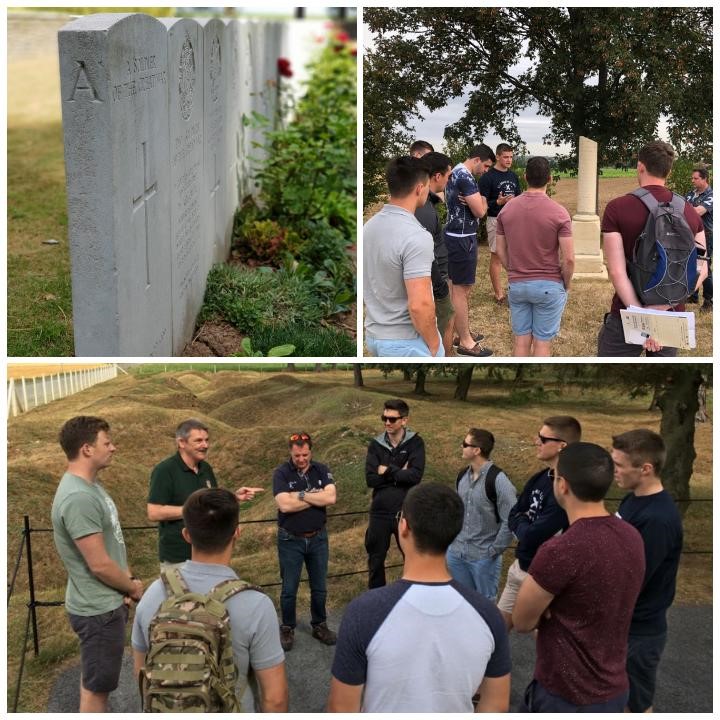57 Squadron - 2008-Present - Flying Training
57 Squadron reformed on 1 October 2008 at RAF Wyton, flying the Grob Tutor aircraft in the RAF’s elementary flying training role, training the RAF’s future operational pilots. As part of a consolidation of elementary flying training, the Squadron relocated to RAF College Cranwell in September 2014. From late 2017, the Squadron began operating the Grob 120TP Prefect aircraft, provided under the UK's Military Flying Training System.
Captain Laurence Minot MC RFC and the Laurence Minot Memorial Trophy

Captain Minôt, pictured in 1917
Born in Wandsworth, Surrey on 21 July 1896, Laurence Minôt (sometimes written as Minot in various records) was the only son of John Edward and Ada Minôt, who resided at 30 Beulah Hill, Upper Norwood.
Educated at Dulwich College, Minôt enrolled at a Royal Flying Corps (RFC) flying school in April 1915, and was awarded his ‘wings’ in July 1916. Commissioned into the RFC as a 2nd Lieutenant, Minôt was almost immediately posted to France where he joined 16 Squadron before transferring to 57 Squadron in 1917 flying DH4 aircraft on reconnaissance and bombing duties.
Credited with 6 ‘kills’, Minôt had reached the rank of Captain when he was killed on 28 July 1917, just one week after his 21st birthday. In action on the previous day, Minôt and his usual observer (Lieutenant Arthur Frederick Britton) had downed 3 enemy aircraft.
| DATE | OBSERVER | AIRCRAFT | OPPONENT | LOCATION |
| 3 July 1917 | Lieutenant Britton | 57 Squadron DH4 (A7487) | Albatross D.V. | Zonnebeke |
| 3 July 1917 | Lieutenant Britton | 57 Squadron DH4 (A7487) | Albatross D.V. | Zonnebeke |
| 7 July 1917 | Air Mechanic 1 Goffe | 57 Squadron DH4 (A7487) | Albatross D.V. | North-east of Ypres |
| 27 July 1917 | Lieutenant Britton | 57 Squadron DH4 (B3963) | Albatross D.V. | Houthulst |
| 27 July 1917 | Lieutenant Britton | 57 Squadron DH4 (B3963) | Albatross D.V. | Houthulst |
| 27 July 1917 | Lieutenant Britton | 57 Squadron DH4 (B3963) | Albatross D.V. | Houthulst |
List of Captain Minot’s Combat Victories
For their actions on 27 July 1917, Captain Minôt was to be posthumously awarded the Military Cross, while Lieutenant Britton would subsequently be awarded the Croix de Guerre. However, as a result of the injuries he sustained on 27 July, Britton (who survived the war, only to die on 19 February 1919 during the great influenza pandemic of that year) was unable to fly with Minôt on 28 July 1917, so 2nd Lieutenant Sidney John Leete was paired with Minôt on that day.
Along with his usual pilot (Lieutenant Irwin), Leete had taken part in the same action on 27 July 1917 as Minôt and Britton. However, like Lieutenant Britton, Lieutenant Irwin had been wounded in the engagement, hence why Minôt and Leete were tasked to fly together as a crew on 28 July.

DH4 aircraft of 57 Squadron (indicated by the white fuselage roundel) engaged in combat with a German Albatross DV aircraft
Taking-off from Boisdinghem at 1615 hours in DH4 A7540 (named ‘Bombay 1’) along with 4 other of 57 Squadron’s aircraft, Minôt and Leete had been briefed to attack the German aerodromes at Heule and Inglemunster. The 57 Squadron formation was intercepted by German Albatross D.V. aircraft of Jasta 6 at 1755 hours. Contemporaneous post-battle reports indicate that A7540 was last seen chasing a German machine towards the ground. It is believed that Minôt and Leete were shot down by Leutnant Hans Ritter von Adam, a German ‘ace’ who was himself subsequently killed in combat on 15 November 1917.
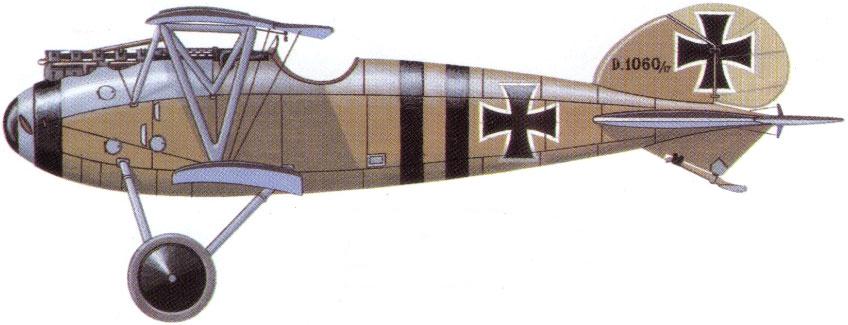
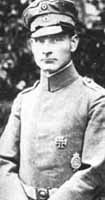
An Albatross DV of Jasta 6
Leutnant Hans Ritter von Adam
Captain Minôt and 2nd Lieutenant Leete are buried alongside each other in the Harlebeke New British Cemetery, West Vlaanderen, Belgium in Plots I.A.14 and I.A.13 respectively. Interestingly, a large memorial dedicated to the memory of Lieutenant Leete stands in the churchyard in Wickford, Essex.
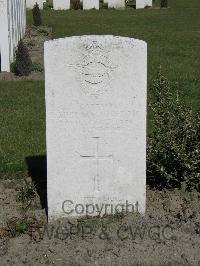
Gravestone marking the final resting place of Captain Minôt

Gravestone marking the final resting place of 2nd Lieutenant Leete
Born in Woodford on 8 June 1893 to Joseph and Catherine Leete, Sidney John Leete was raised and educated in Wickford and worked as a poultry farmer before enlisting into the Army’s 13th Reserve Cavalry Regiment on 21 August 1914 at Scarborough. Initially a corporal, Leete received his commission on 9 May 1915 and transferred to the Worcestershire Regiment before being deployed to France on 25 May 1916 as part of the 8th Worcesters.
Transferring to the RFC in April 1917, Leete returned to France after a period of training in the UK, joining 57 Squadron on 29 June 1917. Heavily involved in bombing and reconnaissance sorties over the next month, Leete was credited with destroying an enemy aircraft on 27 July 1917, the day his pilot, and Captain Minôt’s observer, were wounded in action.

2nd Lieutenant Sidney John Leete, pictured as a corporal in the 13th Reserve Cavalry Regiment
Although Captain Minôt and 2nd Lieutenant Leete were shot down on 28 July 1917, it was sometime later before it was confirmed by the German authorities that both airmen had been killed.
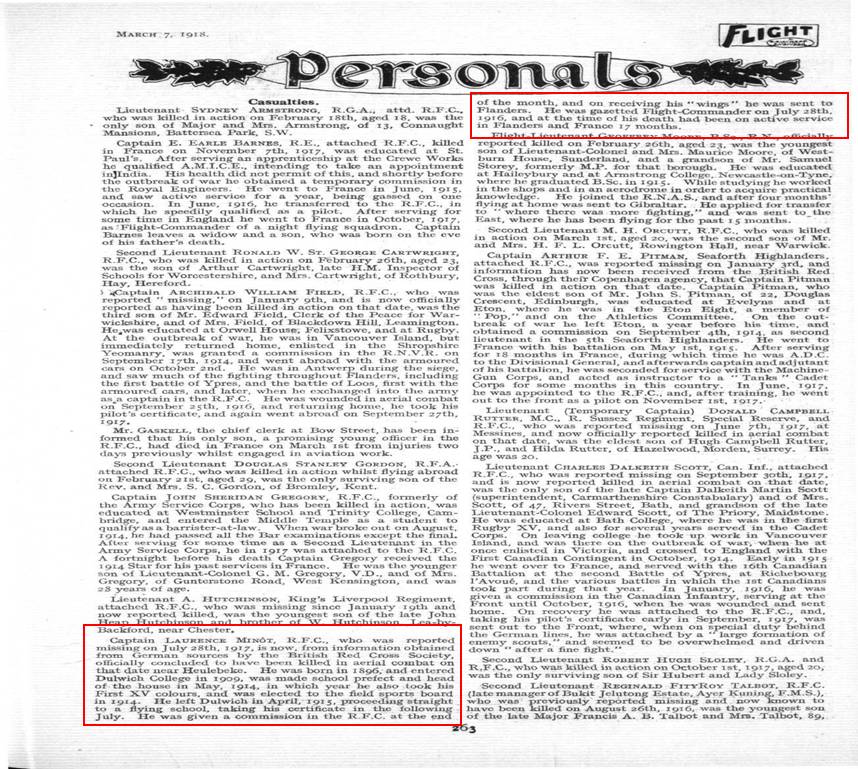
Confirmation of the death of Captain Minôt – Flight & Aircraft Engineer Magazine 7 March 1918
As previously noted, for his conspicuous gallantry and devotion to duty in combat on 27 July 2011, where he and Lieutenant Britton accounted for 3 enemy aircraft, Captain Minôt was posthumously awarded the Military Cross.
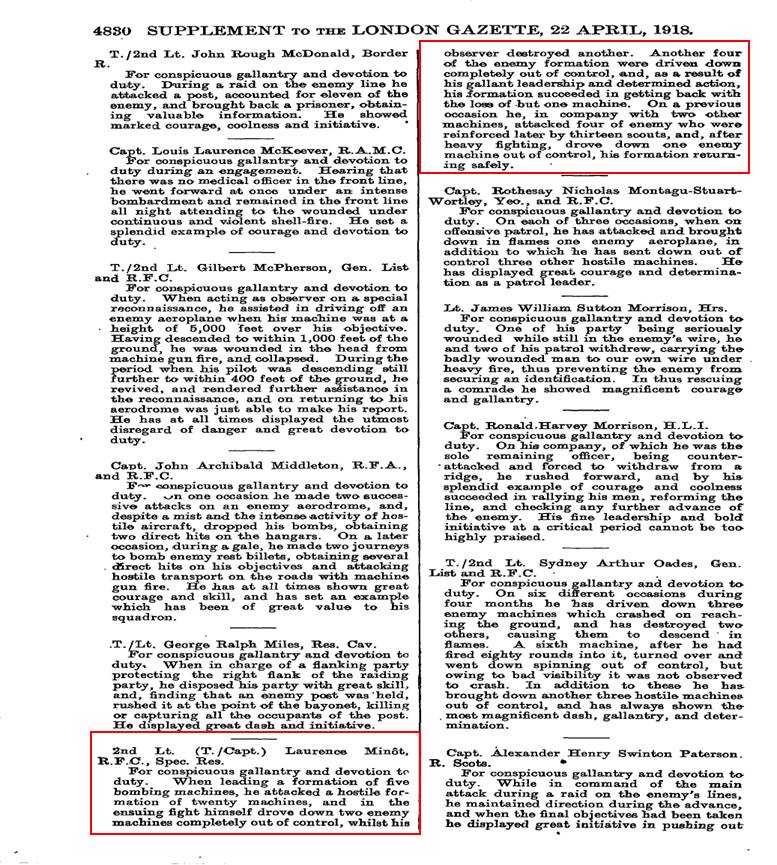
Citation for the award of the Military Cross to Captain Minôt - London Gazette 22 April 1918

Captain Minôt’s official medal record card – National Archive 2011
In 1926, an anonymous benefactor (believed to be a member of Captain Minôt’s family) presented the RAF with a trophy named in honour of Captain Minôt.
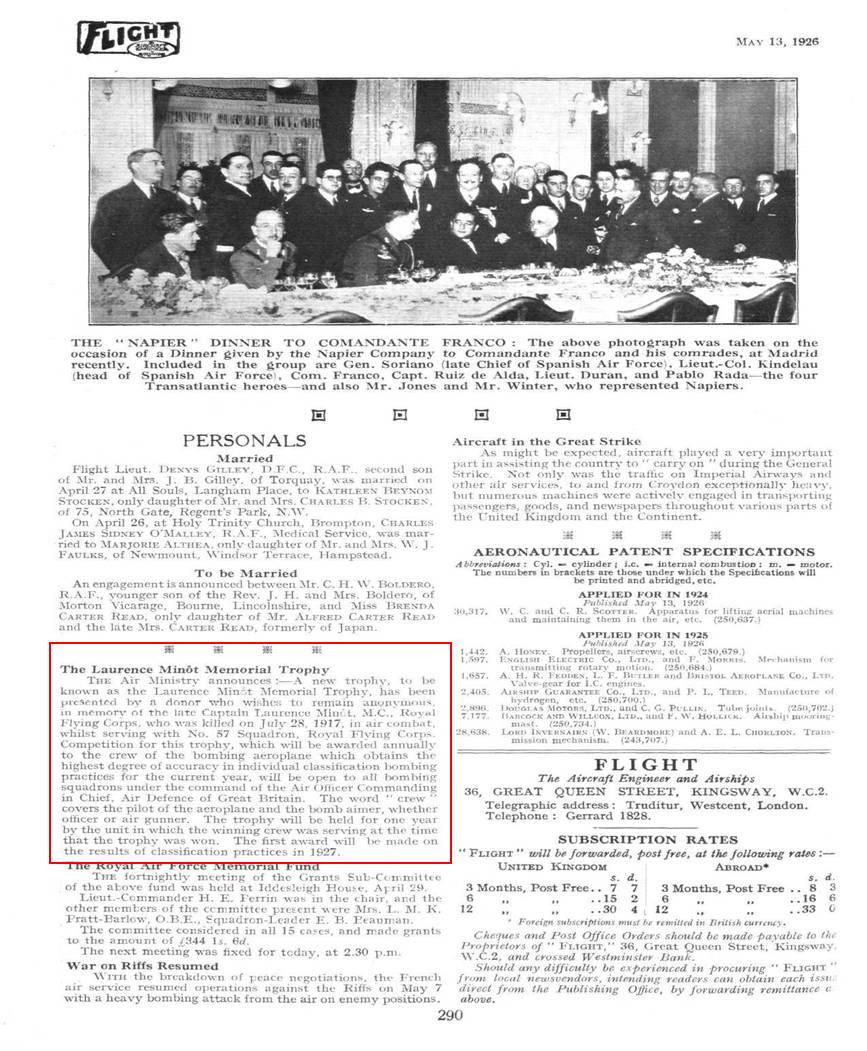
Announcement of the instigation of the Laurence Minôt Memorial Trophy – Flight & Aircraft Engineer Magazine 13 May 1926
Competition for the Laurence Minôt Memorial Trophy was suspended during WWII and in the immediate aftermath of the conflict. However, in 1949, the RAF announced that Bomber Command squadrons could compete for the revived trophy.
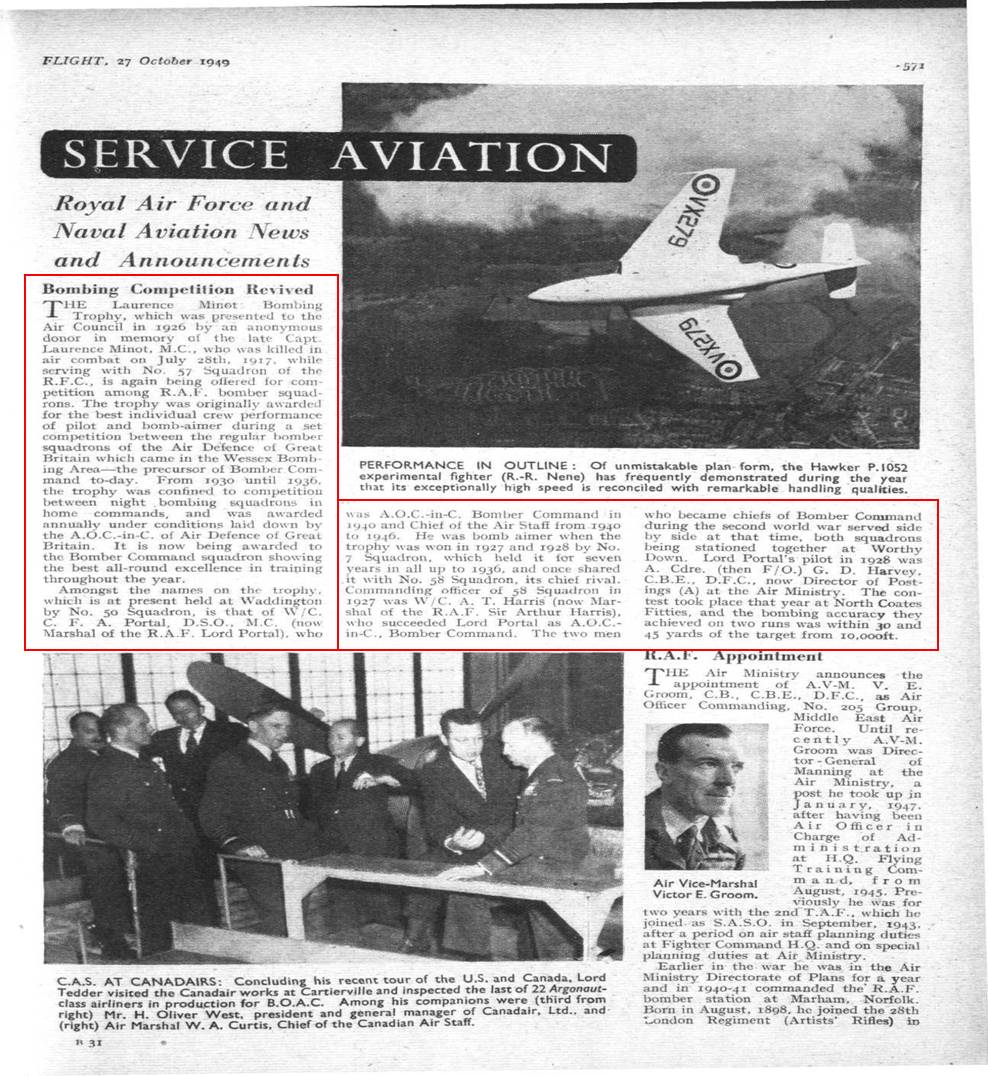
Announcement of the revival of the Laurence Minôt Memorial Trophy – Flight Magazine 27 October 1949
Throughout the 1950’s and 1960’s, the Laurence Minôt Memorial Trophy was fought for fiercely by Bomber Command (and, later, Strike Command) squadrons. However, the annual competition gradually petered out, and the precise location of the Laurence Minôt Memorial Trophy became somewhat unsure!
In late 2009, Group Captain David Houghton asked the appropriate HQ Air Command staffs to try and trace the Laurence Minôt Trophy. After some 18 months of detective work, the staffs established that the trophy was residing in the official home of the Chief of the Air Staff (CAS), Air Chief Marshal Sir Stephen Dalton KCB ADC BSc FRAeS CCMI RAF. A request was therefore made to CAS to allow the Laurence Minôt Trophy to be transferred to 57 Squadron at RAF Wyton, which Air Chief Marshal and Lady Dalton graciously agreed to allow this to happen.
From: 2Gp-Future Brize Gp Capt (Houghton, David Gp Capt)
Sent: 05 May 2011 13:53
To:
Cc:
Subject: 20110505-Request for the Laurence Minot Trophy to be Transferred to 57 Squadron
Sir,
I hope you will forgive me taking the liberty of approaching you (with my President of the 57 & 630 Squadrons’ Association hat on) on a seemingly unimportant matter. In brief, for some time I have been working with HQ AIR Service Funds staffs, RAF High Wycombe to try and locate a silver trophy that has particular meaning to 57 Squadron, and to (hopefully) arrange for the transfer of the trophy to 57 Squadron at RAF Wyton.
The item in question is the Laurence Minot Trophy (I have attached a rather poor print showing the trophy), which was presented to the RAF in 1926 by the family of Capt Laurence Minot MC, who was killed in combat in 1917 while serving with 57 Squadron. For many years, the trophy was awarded to the best bombing squadron in the RAF, but this has not happened (I think) since the 1960’s.
Following some excellent detective work by Service Funds and RAF High Wycombe Officers’ Mess Committee Members, I understand that the Laurence Minot Trophy currently resides at your residence, and is a particular favourite of Lady Dalton.
I believe that Flt Lt Mark Hill plans to discuss with your House Manager the possibility of transferring the Laurence Minot Trophy to its spiritual home on 57 Squadron. While the loss of this trophy from your home would, I am sure, be unwelcome, I can assure you Sir that, if you and Lady Dalton were to agree to such a course of action, its return to 57 Squadron would mean a great deal to those currently serving on Captain Minot’s unit, and would provide a tangible link with the Squadron’s past for the young pilots following in Captain Minot’s footsteps. Indeed, you may wish to be aware that, if you kindly agree to allow the Laurence Minot Trophy to be transferred to 57 Squadron, it is the intention of OC 57 Squadron to present the trophy to the graduate from each course who, in the opinion of the OC, best embodies the enduring fighting spirit of 57 Squadron and Captain Minot.
Sir, I would be most grateful for your consideration of this issue.
I remain Sir, your obedient servant and still recall with fondness my time working for you in DAO.
E-mail from Gp Capt Houghton to Staff Officer/CAS, requesting that CAS consider allowing the Laurence Minôt Trophy to be transferred to 57 Squadron – 5 May 2011
Now returned to its spiritual home with 57 Squadron, it is the intention of the Officer Commanding 57 Squadron to award the Laurence Minôt Memorial Trophy to the student pilot on each course of graduates who, in the opinion of the OC, best embodies the enduring fighting spirit of 57 Squadron and Captain Minôt.
Designed on a much grander scale than most trophies presented to the RAF, the Laurence Minôt Memorial Trophy stands approximately 3½ feet in height.

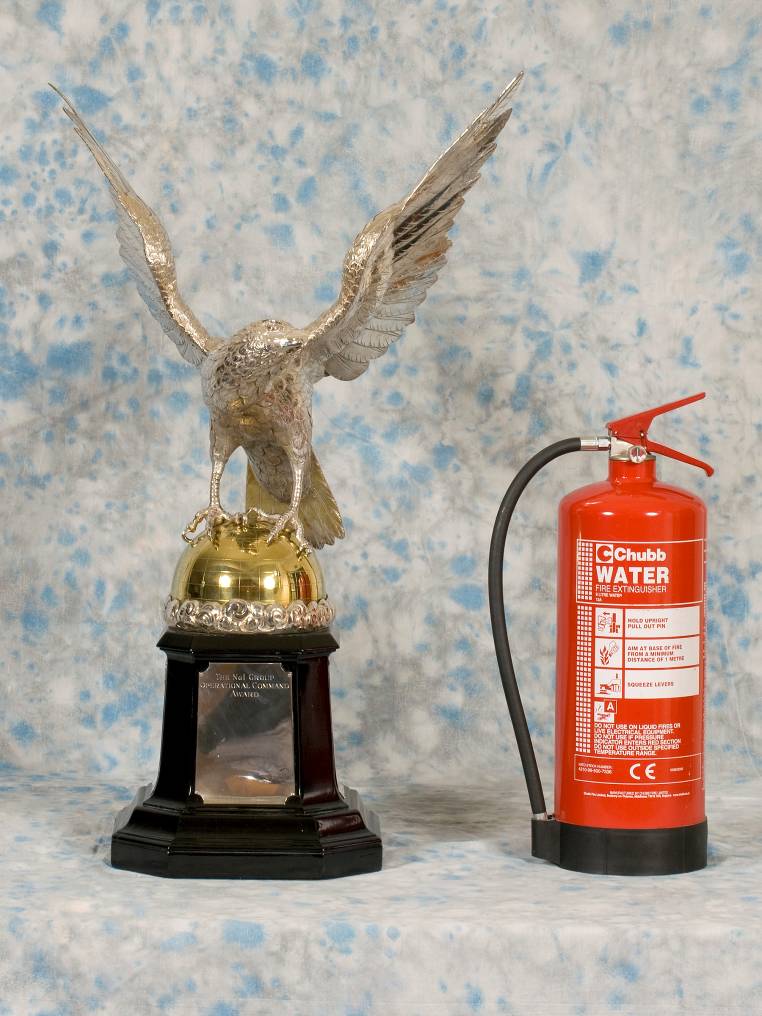
The Laurence Minôt Memorial Trophy in its new home with 57 Squadron, RAF Wyton. As an indicator of the sheer size of the trophy, the fire extinguisher is 2 feet (60 cm) tall
Addendum. In 2019, while researching the story of his great uncle Syd Leete (Minot's observer on his final mission), John Gosling discovered in the National Archives, the identity of the benefactor of the Minot Trophy. Minot's brother-in-law, J.T. Tighe Paxton, donated 50 guineas to the Air Council to buy a 'suitable trophy' in Minot's memory to be 'won annually by an officer of the Royal Air Force for some worthy achievement', on the understanding that his name should not be made public.
Inaugural Presentation of the Phoenix Trophy – December 2010
In 2010, David Francis made a most generous donation to the 57 & 630 Squadrons’ Association coffers. Rather than spend the donation on wine, women and song (and squandering the rest), the Association Committee agreed with David that, instead, we should commission a trophy for 57 Squadron that would commemorate the memory of Sqn Ldr Ray Francis DFC RAF (David’s father and a stalwart of the Association) who died in 2010.
That idea took physical shape in the form of The Phoenix Trophy, a silver rose bowl engraved with a facsimile of the Squadron’s original phoenix emblem from 1916, followed by the inscription:

The Phoenix Trophy Presented to 57 Squadron by the 57 & 630 Squadrons’ Association – 11 Nov 10. In memory of Sqn Ldr Ray Francis DFC RAF.
The obverse of the trophy is engraved with:
To be awarded at the discretion of the Officer Commanding 57 Squadron to the person or group who, in the opinion of the OC, have made an outstanding contribution to the spirit, ethos or professionalism of 57 Squadron.
As is to be expected, The Phoenix Trophy will be awarded infrequently (an individual or group has to make an “outstanding” contribution to 57 Squadron). But, in December 2010, Squadron Leader Paul Watkins (the then OC 57 Squadron) awarded the trophy to Flight Lieutenant Christian Vardy.
Flight Lieutenant Vardy was awarded the trophy because of his unstinting efforts to improve further the standard of instruction on 57 Squadron. Despite being a Flight Commander on the squadron (an exceptionally busy and time-consuming role), Christian still found time to become qualified as an Instrument Rating Examiner on the Grob Tutor, and to achieve a much-coveted A2 (above average) instructor rating from Central Flying School examiners.
Sadly, Flight Lieutenant Vardy has now left 57 Squadron for RAF Brize Norton, where he has become an aircraft captain on 216 Squadron, flying the TriStar aircraft. 57 Squadron’s loss is certainly 216 Squadron’s gain.

Flight Lieutenant Vardy (right) is presented with The Phoenix Trophy by Squadron Leader Paul Watkins (then OC 57 Squadron)
57 Squadron honour the fallen at Amiens
Formed during World War 1 on 8th June 1916, 57 Squadron has a rich history and the squadron has seen many changes over the past 100 years. This year marked 100 years since the Battle of Amiens which was the first phase of the Allied offensive which began on 8th August 1918, later known as the Hundred Days Offensive that ultimately led to the end of World War 1.
57 Squadron staff and students travelled to Amiens in France for a Staff Ride to learn about 57 Squadrons role in World War 1, visit significant areas of the battlefield and pay respects to those on 57 Squadron, and indeed all others, who lost their lives in the Great War.
The staff and students of 57 Squadron were joined by Mr Andy Johnson, an aviation and military researcher, to guide them around Amiens and bring the battlefield to life. The trip started by visiting the crash site of Manfred Von Richtofen, the notorious German fighter ace also known as ‘The Red Baron’, to discuss control of the air and how the Allied and German air strategies differed. Afterwards, the group went on a battlefield tour at Newfoundland Memorial Park to view the battlefield first hand, walk through the preserved trenches and visit the cemetery where many soldiers have been laid to rest. The visit to Newfoundland Park was particularly engaging and a sobering experience.
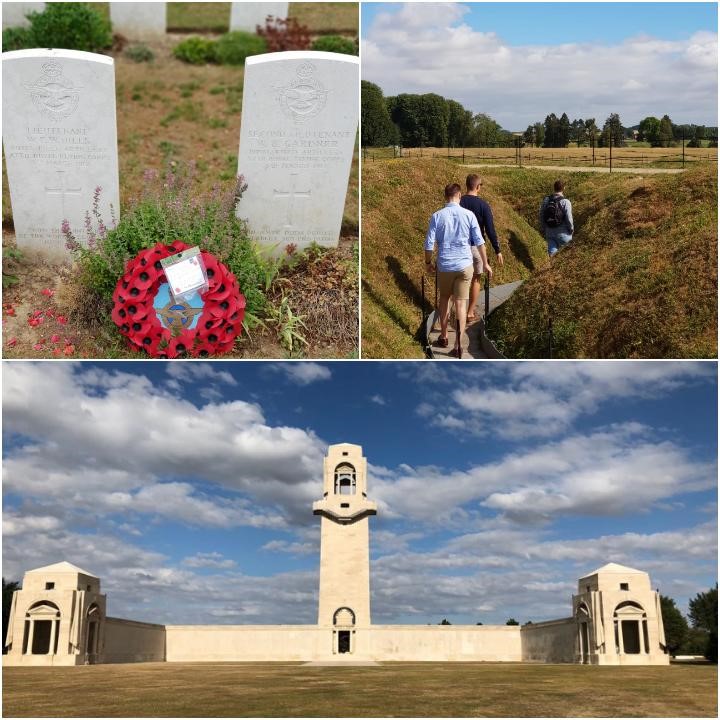
Top Left - The graves of the first two 57 Squadron aircrew that were killed in WW1. Top Right - 57 Squadron students walk through the trenches in Newfoundland Memorial Park. Bottom - Villers-Brettonneux Australian National Memorial.
In the afternoon, Flight Lieutenant Simon Shirley, one of the Squadron’s Qualified Flying Instructors, represented 57 Squadron at a ceremony in Amiens Cathedral, also attended by VIPs including the Prime Minister and HRH Prince William. The rest of the group made their way to Avesnes-le-Comte Communal Cemetery to lay a wreath by the graves of the first two 57 Squadron aircrew combat deaths during World War 1.
The last visit of the day was to the Villers-Brettonneux Australian National Memorial. The scenic location of the memorial, combined with the fantastic weather, led to a truly impressive site. The large tower of the memorial was used during World War II to house machine guns to fire at the enemy. The Luftwaffe desperately tried to destroy these guns by firing at the tower. The damage and holes that the Luftwaffe caused have been left by the French to preserve the history and they are still visible to this day.
The next morning, the group visited a poignant memorial in Bouzencourt, to Captain Francis Leopold Mond and Lieutentant Edgar Meath Martyn of 57 Squadron, to discuss the issues experienced with mistaken identities and informing Next of Kin as both of these men had been incorrectly identified. The final visit of the trip was to a bridge in Peronne that was targeted by the Allied forces during World War 1, opening a discussion on isolating the battlefield and whether it can be done effectively.
